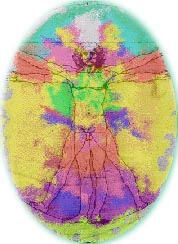Seeing the Aura
Several years ago I was the editor-in-chief of FATE magazine. It was really a thrill to do that because I had been reading FATE since I was a kid.
One of the topics that was always of interest to readers of FATE was the aura. For the Llewellyn Encyclopedia I wrote this about the aura:
[The aura is an] emanation or set of emanations that extends around objects and animals, including the human body. There are multiple beliefs as to the number of different types of auras that extend around the body. Some say there are seven, others say five or three.The aura extends from just above the surface of the skin out to infinity. It becomes more and more ethereal as it extends further from the body, and beyond about three feet even people who can see auras are not able to detect it. The smoothness of each aura level, as well as the pureness of its color, are said to indicate the conditions of the person they surround.
In the three-fold system of interpretation, the area closest to the skin is said to relate to your physical well-being. Outside of this physical aura is the mental aura that relates to your state of mind. It could be called the psychological aura. The third part of the aura is the spiritual element. It relates to your spiritual advancement and is further away from the body than is the mental aura. Actually, all three are said to interrelate and overlap…
Many occult groups highly value being able to see the aura and interpret its meaning. The original Hermetic Order of the Golden Dawn would have someone who specialized in auric vision check out your aura before you could become a member. Personally, I suspect this was a way for a few people to have a bit more power than they should by giving thumbs up or thumbs down to a potential initiate. After all, what recourse did you have to someone claiming your aura was off?
Seeing the aura, therefore, was not only a cool skill to develop, it was also a valuable tool to have. For years, FATE magazine advertised “Aura Goggles.” These were invented by Dr. Walter Kilner, and he described them in a book.
They were made from two pieces of glass between which was a dark purple dye known as dicyanin. Here is what an antique pair of them looked like:
Unfortunately, the dye became hard to obtain and today people just use dark purple lenses that may or may not filter the proper wavelengths. I’ve seen modern versions priced from $20 up to $200. Luckily, you don’t have to spend that much. Here is my simple method for developing auric vision.
Method 1
Requirements:
- A flashlight that can stand on end so that the light shines upward. Its light should not be very bright.
- A piece of black construction paper, about 8.5 x 11 inches in size
Technique:
- Step one: In a comfortable room, sit in a chair at a table and dim the lights so that the room is dark. It does not have to be totally dark.
- Step two: Put the flashlight on the table and turn it on, with the light pointed upward.
- Step three: With either hand, hold the sheet of black paper above the light so that it is “backlit” and the glow of the light can be seen around the edge of the paper.
- Step four: Hold your other hand about 1–3 inches in above the paper.
- Step five: Look at your hand above the paper, then allow your vision to go “soft” by trying to visually see as wide an area as possible. Don’t blink. If your eyes water, let them water.
- Step six: In a few minutes you should be able to see a faint hazy glow around your hand. It is variously reported as white, silver, gray, or golden in color. Once you see it, focus on it. What does it feel like when you see this glow?
What you are observing is the physical aura. With practice you will be able to repeat the sensation without the dark room and paper. That is the particular sensation you feel when you are seeing the aura.
Method 2
Requirements:
- A table
- A chair
- A table lamp with a low-wattage bulb
- A standard sheet of black poster board (about 22 x 28 inches)
- An easel to hold up the sheet of poster board on the table
Technique:
- Step one: This is for a group of people. Set up the table with the lamp on it. Put up the easel and place the poster board on the easel. Put the chair in front of the table.
- Step two: Turn out the room light and turn on the table lamp. That should be the only lamp in the room.
- Step three: A volunteer should sit in the chair so that the posterboard is behind that person’s head and shoulders.
- Step four: The audience should look at the volunteer’s head, then allow their vision to go “soft” by trying to visually see as wide an area as possible. Don’t blink. If your eyes water, let them water.
- Step five: In a few minutes members of the audience will start to see a faint hazy glow around the volunteer’s head. It is variously reported as white, silver, gray, or golden in color. Once people see it they should focus on it and on the sensation they get when they see it.
- Step six: After a few minutes, repeat with another volunteer.
With practice, you should be able to repeat the sensation at any time and place. What you’re seeing is the aura.
What Does it Mean?
The ability to see the aura means, well, it means you can see the aura. With practice, you’ll be able to expand your vision so you can see different levels of the aura. You’ll also be able to see different colors. Here is a supposed image of the aura made using a fancy and expensive machine:
You’ll notice different colors around the figure and their interplay. And this is where the challenge of aura interpretation comes in. Where does one level of the aura end and the next begin? There’s no fine line. Similarly, where does blue end and purple begin? In fact, what you call blue, I might call indigo or even purple. This means any book that says a particular color in the aura means something should be taken with a grain of salt…or maybe a mine of salt.
Use books as resources, not facts written in stone! When you see a color in the aura, ask the person about it. If the color was in the physical part of the aura, ask about their health. If the color is in the mental part of the aura, ask what that person feeling or thinking. If it’s in the spiritual part of the aura, ask about their spiritual practices. If the color goes through different levels, you may inquire about several things. In this way you’ll be able to develop your own vocabulary of what colors, shades, intensities, and nuances of the colors in the aura actually mean. In this way you can perfect your ability to interpret the aura.
This doesn’t mean ignore books on the subject of aura vision. They can be valuable tools. Three I recommend include:
.
.
.
..How to See and Read the Aura by Ted Andrewsby Ted Andrews
.
.
 Auras: See Them in Only 60 Seconds by Mark Smith, and
Auras: See Them in Only 60 Seconds by Mark Smith, and
The Compete Book of Auras by Richard Webster…
.
.
.
.












Hi Don,
I might add that another technique to see the aura is to do the LBRP as described in your book Modern Magick. I actually became aware of my aura when I was connecting two pentagrams with my right index finger. While visualizing a white screen of light I noticed a soft column of white light coming from my finger. I remember reading in your book that the ritual made the aura bigger, but that did not mean much to me at the time. Now I cannot imagine not being able to see my aura. How could I have missed it all these years? Thank you for your amazing book. I am now hooked on magick!
Richard
I want to purchase aura goggles.